After years of mastering Thai recipes, I’ve refined this Moo Hong recipe to bring out the most tender, melt-in-your-mouth texture, balanced with the sweet and savory notes that make it so beloved in Thailand. My technique provides a flavor that’s as close to Phuket’s original as you’ll find outside Thailand.

This recipe uses just a handful of ingredients, keeping the process simple and straightforward, allowing the pork belly to slowly absorb rich flavors. With my step-by-step photo instructions, you can trust that each detail is created to make sure your Moo Hong turns out tender and flavorful every time.
For more pork belly recipes you'll love, try these, Gaeng Hung Lay curry, Thai crispy pork belly, pork belly with five spice powder, Thai yellow curry with pork belly, Pork belly stir fry with Chinese Broccoli, and Pad Prik Khing pork belly stir fry.
Jump to:
- What is Moo Hong
- Moo Hong vs. Moo Palo
- Why You’ll Love This Stewed Pork Belly Recipe
- Ingredient List for Thai Pork Belly Stew Recipe
- How to Make Moo Hong- Phuket Pork Belly Stew
- How to Serve Moo Hong
- Kitchen Tips for the Perfect Stew
- How to Store leftovers
- Frequently Asked Questions
- Moo Hong - Thai Pork Belly Stew
- Related Recipes
What is Moo Hong
Moo Hong is a traditional Thai dish originating from Phuket, a tourist destination in southern Thailand. It is known for its tender pork belly stewed and then reduced in sweet, dark soy sauces, creating a sticky, savory, flavorful sauce. It's a beloved Southern Thai delicacy that's hearty, comforting, and bursting with aromatic herbs and spices.
Moo Hong vs. Moo Palo
It’s easy to mix up Moo Hong and Moo Palo since they’re pretty similar. Moo Palo packs in more spices using five-spice powder and usually features hard-boiled eggs, while Moo Hong keeps it simple with just one or two spices. Typically, star anise is the star of Moo Hong, but you can always add your twist with extras like cinnamon sticks or cloves. For an authentic taste, it’s best to keep the spices to a minimum so the delicious pork belly can shine!
Why You’ll Love This Stewed Pork Belly Recipe
- Simple yet flavorful: This recipe is packed with the bold flavors of Thai cooking, but it’s incredibly easy to make. I’ve broken it down step by step, with details on where to buy the ingredients, which brands to use, and even suggestions for optional spices if you want to add a little extra kick—without straying from the authentic taste.
- Minimal ingredients, maximum flavor: The beauty of Moo Hong is in its simplicity. With just a few ingredients—especially when it comes to spices—you’ll still create a dish that feels rich and complex. Want to amp up the flavor? I’ve got you covered with some easy-to-add suggestions.
- Melt-in-your-mouth pork belly: The pork belly in this dish is so tender that it practically melts in your mouth. It’s a luxurious, comforting bite that’s sure to impress, and the best part? It’s an easy recipe that will make your friends think you spent hours perfecting this Thai delicacy!
- Aromatic comfort food: The combination of tender pork belly cubes and aromatic spices creates a satisfying, soul-warming dish perfect for any time of year. Whether it’s a cozy dinner or a special meal, Moo Hong is a recipe you’ll want to make again and again.
Ingredient List for Thai Pork Belly Stew Recipe

- Cilantro stems: In Thailand, cilantro is usually sold with roots attached, a key element in authentic Thai recipes. In the U.S., finding cilantro with roots is rare (think farmer’s market in spring), so I use the thickest, lowest stems for a similar flavor.
- Garlic: Essential in the seasoning paste alongside cilantro and white pepper, adding depth and aroma to the stew.
- White peppercorns: Whole peppercorns give the best flavor, but black peppercorns work, too, if that’s what you have.
- Pork belly: Look for a pork belly with the skin on. While mainstream grocery stores often sell skinless cuts, Asian markets usually carry them with the skin.
- Salt: Any kind will work.
- Water is the stew’s base, though you can substitute unsalted stock or broth for extra flavor.
- Star anise: Adds a warm, aromatic note to the stew.
- Palm sugar: Adds a mellow sweetness. You can substitute brown sugar, but for palm sugar, try a soft paste version for ease or shave small amounts from solid palm sugar pucks.
- Thai sweet soy sauce: It brings sweetness and deep color to the stew. Try brands like Healthy Boy or Kwong Hung Seng, both are available in most Asian markets.
- Thai Oyster sauce: Adds rich umami depth and color to the braising liquid. I recommend the Mae Krua brand for a truly Thai flavor.
- Thai soy sauce: Also called thin or light soy sauce. It provides a touch of saltiness to balance the dish. You can substitute other brands here if necessary.
- Cilantro leaves: Finish with fresh leaves for a bright garnish.
How to Make Moo Hong- Phuket Pork Belly Stew
1. Make the Seasoning Paste: Roughly chop cilantro stems or roots into ½-inch pieces. Place in a mortar with peeled whole cloves garlic and ground white pepper, then pound into a rough paste with a mortar and pestle. Check the tips section below if you don't have a mortar.


2. Brown the Pork Belly: Cut the pork belly into 2-inch cubes, keeping the skin and fat on for maximum flavor and texture. Add the pork to a Dutch oven or soup pot over medium high heat, without any oil, to render the fat and lightly golden brown the pieces, about 4-5 minutes. Remove the pork belly chunks from the pot and save the rendered fat.
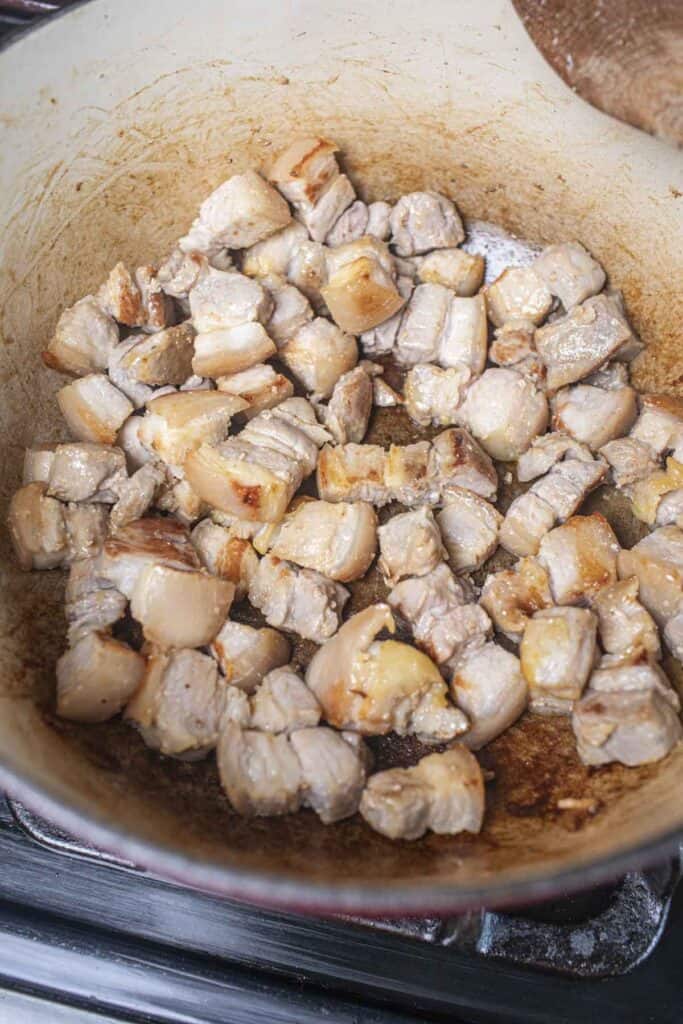

3. Fry the Seasoning Paste: Using the rendered fat in the pot, add the paste and fry until fragrant, about 20-30 seconds.
4. Coat and Simmer: Add the browned pork belly back to the pot, stirring to coat it well in the fried paste. Add water and bring to a boil over medium-high heat. Reduce the heat to medium, then add salt, sugar, soy sauce, oyster sauce, and star anise. Stir, cover, and let simmer for 25-35 minutes or until the pork is fall-apart tender.
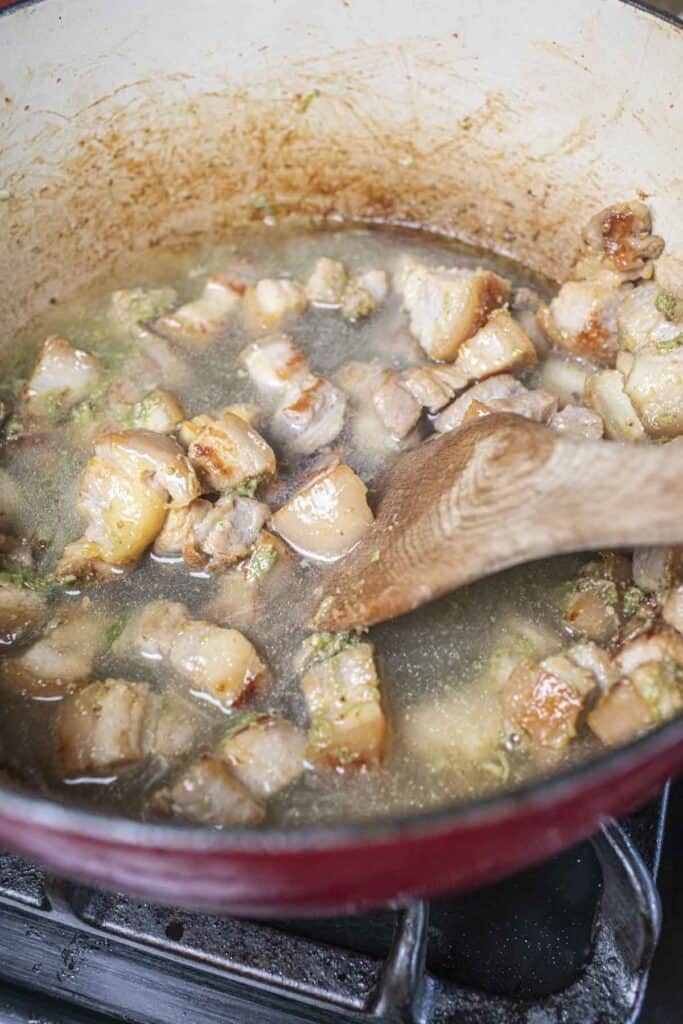
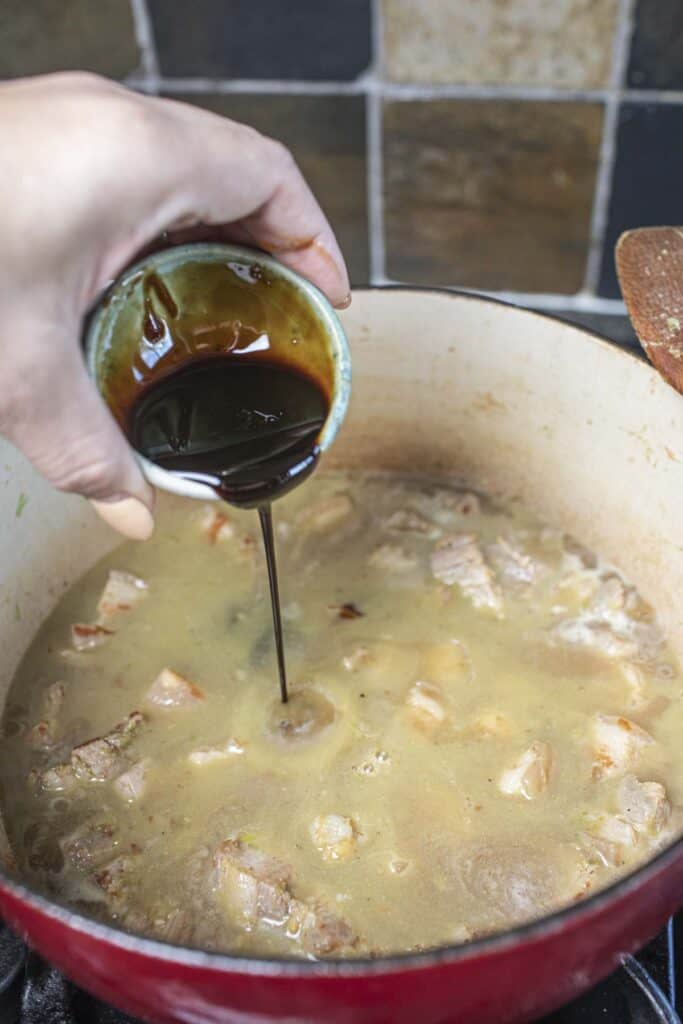
5. Thicken the Sauce: Check the stew a few times, allowing the sauce to simmer until it thickens to a sticky, glossy consistency. If needed, cook an additional 4-5 minutes to reach the desired tenderness. Adjust seasoning with more soy sauce or sugar to taste.


6. Serve: Remove from heat and serve hot with Thai jasmine rice. Garnish with cilantro leaves, and enjoy!
How to Serve Moo Hong
- Serve Moo Hong, a Phuket-style pork belly stew, with a side of jasmine or sticky rice for the ultimate comfort meal. Top with fresh cilantro or chopped green onions to add a burst of flavor and freshness.
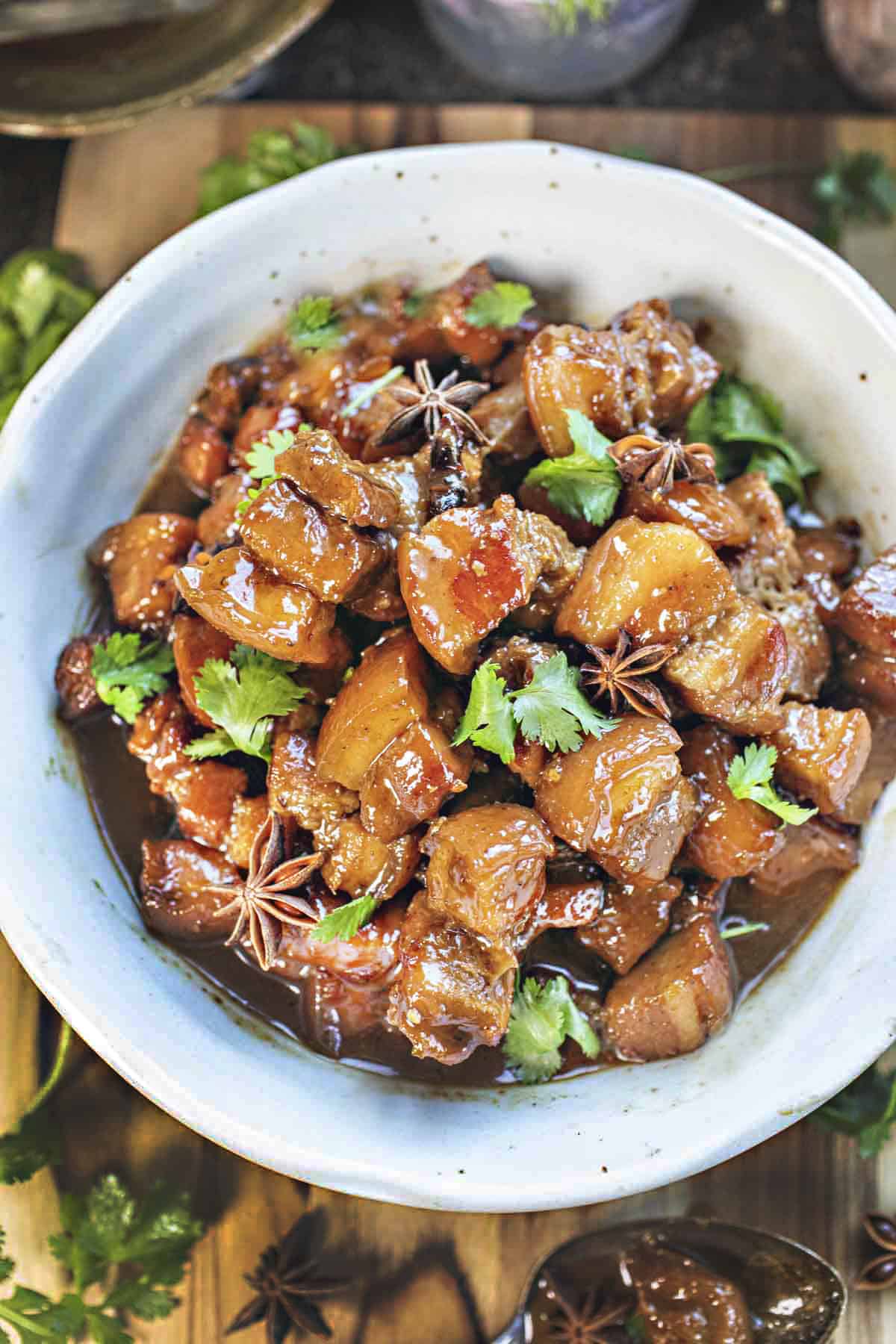
Kitchen Tips for the Perfect Stew
- Finely mince the cilantro, garlic, and pepper if you don’t have a mortar and pestle.
- For an extra layer of aroma, add two cinnamon sticks during cooking.
- Prefer a more spices? Try adding ½ teaspoon of whole cloves and 4 bay leaves.
- Let the stew simmer gently for a truly tender, flavorful pork belly.
- Add 1 ½ tablespoons of Chinese rice wine for an extra depth of flavor.

How to Store leftovers
- Keep leftover Moo Hong in an airtight container in the refrigerator for up to two days.
Frequently Asked Questions
Pork belly is a fatty, boneless cut of meat taken from the underside of a pig, specifically the belly area.
Pork belly has a rich, savory flavor with a tender, melt-in-your-mouth texture.
Pork belly comes from the underside of the pig, specifically the belly area
**Enjoyed this recipe? Please leave a 5-star rating in the comment section below! And follow me on Facebook, Pinterest, or Instagram**
Print
Moo Hong - Thai Pork Belly Stew
- Total Time: 1.15 hours
- Yield: 4 servings
Description
After years of mastering Thai recipes, I’ve refined this Moo Hong recipe to bring out the most tender, melt-in-your-mouth texture, balanced with the sweet and savory notes that make it so beloved in Thailand. My technique provides a flavor that’s as close to Phuket’s original as you’ll find outside Thailand.
Ingredients
- ¼ cup cilantro stems, chopped into 1-inch pieces
- 5 large clove garlic
- 1 tablespoon white peppercorns. Black peppercorns work, too.
- 1 ⅕ pound pork belly, sliced into 1 ½ inch pieces
- 1 teaspoon salt
- 2 cups water
- 6 Star anise
- ¼ cup palm sugar. You can substitute brown sugar, but for palm sugar, try a soft paste version for ease or shave small amounts from solid palm sugar pucks
- 2 tablespoons Thai sweet soy sauce. Try brands like Healthy Boy or Kwong Hung Seng.
- 2 tablespoons Thai Oyster sauce. I recommend the Mae Krua brand for a truly Thai flavor.
- 1 tablespoon Thai soy sauce: Also called thin or light soy sauce.
- Cilantro leaves: Finish with fresh leaves for a bright garnish.
Instructions
- Make the Seasoning Paste: Roughly chop cilantro stems or roots into ½-inch pieces. Place in a mortar with peeled whole cloves garlic and ground white pepper, then pound into a rough paste with a mortar and pestle. Check the tips section below if you don't have a mortar.
- Brown the Pork Belly: Cut the pork belly into 2-inch cubes, keeping the skin and fat on for maximum flavor and texture. Add the pork to a Dutch oven or soup pot over medium high heat, without any oil, to render the fat and lightly golden brown the pieces, about 4-5 minutes. Remove the pork belly chunks from the pot and save the rendered fat.
- Fry the Seasoning Paste: Using the rendered fat in the pot, add the seasoning paste and fry until fragrant, about 20-30 seconds.
- Coat and Simmer: Add the browned pork belly back to the pot, stirring to coat well in the fried paste. Add water and bring to a boil over medium-high heat. Reduce the heat to medium, then add salt, sugar, soy sauce, oyster sauce, and star anise. Stir, cover, and let simmer for 25-35 minutes or until the pork is fall-apart tender.
- Thicken the Sauce: Check the stew a few times, allowing the sauce to simmer until it thickens to a sticky, glossy consistency. If needed, cook an additional 4-5 minutes to reach the desired tenderness. Adjust seasoning with more soy sauce or sugar to taste.
- Serve: Remove from heat and serve hot with Thai jasmine rice. Garnish with cilantro leaves, and enjoy!
Notes
- If you don’t have a mortar and pestle, finely mince the cilantro, garlic, and pepper.
- For an extra layer of aroma, add two cinnamon sticks during cooking.
- Prefer a more spices? Try adding ½ teaspoon of whole cloves and 4 bay leaves.
- Let the stew simmer gently for a truly tender, flavorful pork belly.
- Add 1 ½ tablespoons of Chinese rice wine for an extra depth of flavor.
- Prep Time: 20
- Cook Time: 45
- Category: Pork Recipes
- Method: Stew
- Cuisine: Thai
**Thank you for visiting! Sharing these recipes is my passion, and I’d be thrilled if you’d pass them along to friends—your support means the world!**
Related Recipes
Looking for other recipes like this? Try these pork belly recipes.




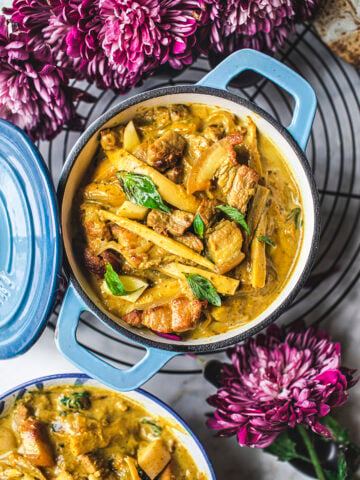



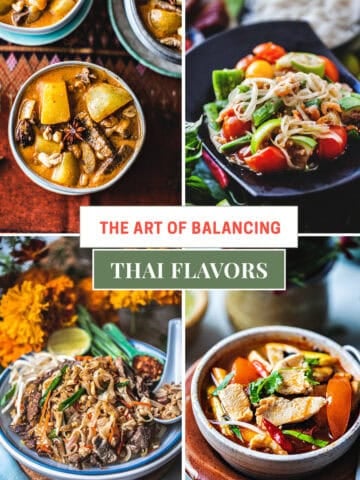
Mark says
Perfect dish for this cooler time of year. However, I’ll happily eat it all year-round!
Yam says
Wow looks so delicious; I like belly pork recipe I will try to do it. Thanks a lot.